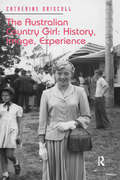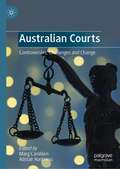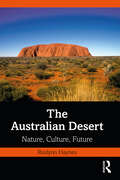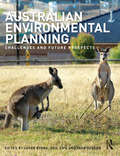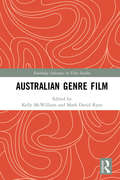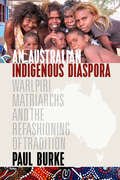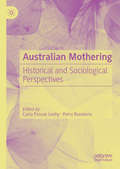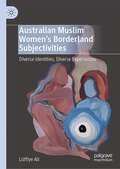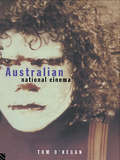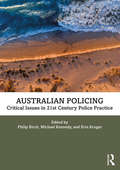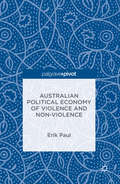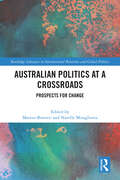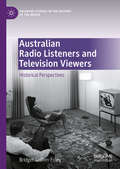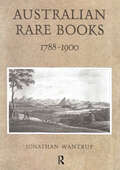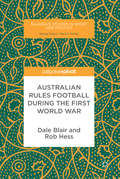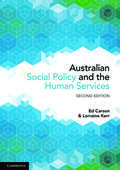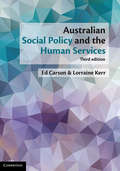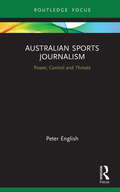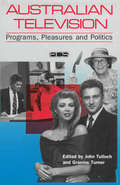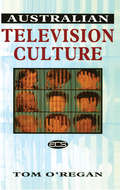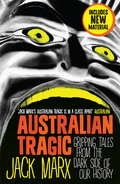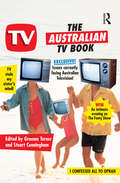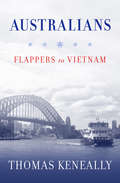- Table View
- List View
The Australian Country Girl: History, Image, Experience
by Catherine DriscollThe Australian Country Girl: History, Image, Experience offers a detailed analysis of the experience and the image of Australian country girlhood. In Australia, 'country girl' names a field of experiences and life-stories by girls and women who have grown up outside of the demographically dominant urban centres. But it also names a set of ideas about Australia that is surprisingly consistent across the long twentieth century despite also working as an index of changing times. For a long period in Australian history, well before Federation and long after it, public and popular culture openly equated 'Australian character' with rural life. This image of Australian-ness sometimes went by the name of the 'bush man', now a staple of Australian history. This has been counterbalanced post World War II and increased immigration, by an image of sophisticated Australian modernity located in multicultural cities. These images of Australia balance rather than contradict one another in many ways and the more cosmopolitan image of Australia is often in dialogue with that preceding image of 'the bush'. This book does not offer a corrective to the story of Australian national identity but rather a fresh perspective on this history and a new focus on the ever-changing experience of Australian rural life. It argues that the country girl has not only been a long-standing counterpart to the Australian bush man she has, more importantly, figured as a point of dialogue between the country and the city for popular culture and for public sphere narratives about Australian society and identity.
Australian Courts: Controversies, Challenges and Change
by Alistair Harkness Marg CamilleriThis edited collection brings together scholars and practitioners in every chapter to provide a comprehensive and unique exploration of courts in Australia. The primary focus is to identify controversies, challenges and change, in the form of potential reforms within the courts across Australian jurisdictions. Bringing forward original research and scholarship on a wide array of courts in Australia, combined with insightful practitioner perspectives, research will be effectively integrated with practice. This book is the first comprehensive collection of its kind to canvas the diversity of courts in Australia, providing comprehensive critical analysis of contemporary issues, debates and reforms. It considers the array of courts across state, territory and national jurisdictions in Australia, including coroners’ courts, family courts, criminal, civil courts and problem solving courts. It also adopts an intersectional approach, providing insights into the perspectives of various court users such as people with disability, ethnic minorities, Indigenous Australians, and victims of crime. Each chapter provides opportunities for further debate among scholars, practitioners and students regarding potential future directions for reform to improve the efficacy, equity and accessibility of Australian courts.This collection serves as an international ready reference for students, scholars and practitioners alike.
The Australian Desert: Nature, Culture, Future
by Roslynn HaynesThis unique book is the only fully interdisciplinary and comprehensive study of the Australian desert and its pivotal role in the cultural history of Australia.Beginning with the prehistory of the continent, it engages with geology, the Aboriginal Dreaming narratives of origin, the arrival of the first Australians, Aboriginal culture of the Dreaming, anthropology, colonial history and the cult of the inland explorer-hero, and integration of the central deserts through the responses of writers, artists, and filmmakers into the national identity. Chapters explore the unique way Indigenous artists have evolved a method of expressing their spiritual relationship to Country, while hiding from uninitiated eyes the secret-sacred meaning beneath the paint. It takes us on a journey through the politics of Land Rights for First Nations peoples, the Uluru Statement from the Heart, and an analysis of Indigenous ecological principles which may suggest a new and radical approach to navigating climate change in the Anthropocene.The Australian Desert is written for scholars of fine arts, anthropology, literature, film studies, cultural history, Indigenous studies, ecology and tourism, and for anyone interested in deserts.
Australian Environmental Planning: Challenges and Future Prospects
by Jason Byrne Neil Sipe Jago DodsonWinner of the Planning Institute of Australia's 2015 Cutting Edge Research and Teaching Award! Australians from all walks of life have begun to realise the nation’s cities cannot sustain profligate growth indefinitely. Dwindling water supplies, failing food bowls, increased energy costs, more severe bushfires, severe storms, flooding, coastal erosion, rising transport expenses, housing shortages and environmental pollution are now daily news headlines. Australia’s cities may have reached their ecological limits: a new model for planning the places we live is needed. Understanding the natural cycles of the city is just as important to planning our cities as knowledge of local ordinances, indeed much more so. A profound knowledge of environmental processes is critical for successful planning in today’s world. Environmental planners take as their guiding principle the concept of designing with nature, approaching cities as living organisms that consume water, energy and raw materials, and produce waste. This metabolic view of cities means we can find new solutions to old problems, and steer our cities towards a more sustainable form of planning. Written specifically for students and professionals working in city planning in Australia, this ground-breaking new book enables Australian planners, architects and developers to get a better understanding of the fundamental principles of environmental planning for cities, showing how land, water, air, energy, wildlife and people shape our built environments, and how in turn environmental processes must be better understood if we are to make informed decisions about developing cities that are more sustainable. The book’s coverage is comprehensive: from an overview of the concepts and theories of environmental planning, through analysis of governance systems and urban environmental processes to agendas and policies for the future, all the key topics are covered in depth, with recommendations for supporting reading and an unrivalled selection of additional materials. Ideal for students, essential for professionals, Australian Environmental Planning is vital reading for more sustainable cities in a more sustainable world.
Australian Genre Film (Routledge Advances in Film Studies)
by Kelly McWilliamAustralian Genre Film interrogates key genres at the core of Australia’s so-called new golden age of genre cinema, establishing the foundation on which more sustained research on film genre in Australian cinema can develop. The book examines what characterises Australian cinema and its output in this new golden age, as contributors ask to what extent Australian genre film draws on widely understood (and largely Hollywood-based) conventions, as compared to culturally specific conventions of genre storytelling. As such, this book offers a comprehensive and up-to-date survey of Australian genre film, undertaken through original analyses of 13 significant Australian genres: action, biopics, comedy, crime, horror, musical, road movie, romance, science fiction, teen, thriller, war, and the Western. This book will be a cornerstone work for the burgeoning field of Australian film genre studies and a must-read for academics; researchers; undergraduate students; postgraduate students; and general readers interested in film studies, media studies, cultural studies, Australian studies, and sociology.
An Australian Indigenous Diaspora: Warlpiri Matriarchs and the Refashioning of Tradition
by Paul Burke<p>Some indigenous people, while remaining attached to their traditional homelands, leave them to make a new life for themselves in white towns and cities, thus constituting an “indigenous diaspora”. <p>This innovative book is the first ethnographic account of one such indigenous diaspora, the Warlpiri, whose traditional hunter-gatherer life has been transformed through their dispossession and involvement with ranchers, missionaries, and successive government projects of recognition. <p>By following several Warlpiri matriarchs into their new locations, far from their home settlements, this book explores how they sustained their independent lives, and examines their changing relationship with the traditional culture they represent.</p>
Australian Mothering: Historical and Sociological Perspectives
by Petra Bueskens Carla Pascoe LeahyThis collection defines the field of maternal studies in Australia for the first time. Leading motherhood researchers explore how mothering has evolved across Australian history as well as the joys and challenges of being a mother today. The contributors cover pregnancy, birth, relationships, childcare, domestic violence, time use, work, welfare, policy and psychology, from a diverse range of maternal perspectives. Utilising a matricentric feminist framework, Australian Mothering foregrounds the experiences, emotions and perspectives of mothers to better understand how Australian motherhood has developed historically and contemporaneously. Drawing upon their combined sociological and historical expertise, Bueskens and Pascoe Leahy have carefully curated a collection that presents compelling research on past and present perspectives on maternity in Australia, which will be relevant to researchers, advocates and policy makers interested in the changing role of mothers in Australian society.
Australian Muslim Women’s Borderland Subjectivities: Diverse Identities, Diverse Experiences
by Lütfiye AliThis book claims a discursive space in academic scholarship for knowledges and ways of knowing that capture the diversity, complexity and full humanness of Australian Muslim women’s subjectivities. It draws on in-depth conversational interviews with 20 Australian Muslim women from various ethnic backgrounds during which the women shared their experiences of being at the crossroads of their religious, gendered, racialised and ethnic identities. The book puts forward a decolonial feminist border methodology by weaving the work of decolonial feminist philosophers Maria Lugones and Gloria Anzaldúa with postmodern feminist thinking on subjectivity and with discourse analysis. This methodology is used to centre and attend to the fluidity and plurality of Muslim women’s subjectivities, at the intersections of race, ethnicity, patriarchy, gender, sexuality and Islam.
Australian National Cinema
by Tom O'ReganTom O'Regan's book is the first of its kind on Australian post-war cinema. It takes as its starting point Bazin's question 'What is cinema?'and asks what the construct of a 'national' cinema means. It looks at the broader concept from a different angle, taking film beyond the confines of 'art' into the broader cultural world. O'Regan's analysis situates Australian cinema in its historical and cultural perspective producing a valuable insight into the issues that have been raised by film policy, the cinema market place and public discourse on film production strategies. Since 1970 Australian film has enjoyed a revival. This book contains detailed critiques of the key films of this period and uses them to illustrate the recent theories on the international and Australian cinema industries. Its conclusions on the nature of the nation's cinema and the discourses within it are relevant within a far wider context; film as a global phenomenon.
Australian Policing: Critical Issues in 21st Century Police Practice
by Philip Birch Michael Kennedy Erin KrugerThis edited collection brings together leading academics, researchers, and police personnel to provide a comprehensive body of literature that informs Australian police education, training, research, policy, and practice. There is a strong history and growth in police education, both in Australia and globally. Recognising and reflecting on the Australian and New Zealand Policing Advisory Agency (ANZPAA) education and training framework, the range of chapters within the book address a range of 21st-century issues modern police forces face. This book discusses four key themes: Education, training, and professional practice: topics include police education, ethics, wellbeing, and leadership Organisational approaches and techniques: topics include police discretion, use of force, investigative interviewing, and forensic science Operational practices and procedures: topics include police and the media, emergency management, cybercrime, terrorism, and community management Working with individuals and groups: topics include mental health, Indigenous communities, young people, hate crime, domestic violence, and working with victims Australian Policing: Critical Issues in 21st Century Police Practice draws together theoretical and practice debates to ensure this book will be of interest to those who want to join the police, those who are currently training to become a police officer, and those who are currently serving. This book is essential reading for all students, scholars, and researchers engaged with policing and the criminal justice sector.
Australian Political Economy of Violence and Non-Violence
by Erik PaulThis book is the first to establish the nature and causes of violence as key features in the political economy of Australia as an advanced capitalist society. Australia's neoliberal corporate security state in seen to represent the emergence of a post-democratic order, whereby minds and bodies are disciplined to the dominant ideology of market relations. Locating questions of the democracy and of the country's economy at the heart of Australia's political struggle, the author elaborates how violence in Australia is built into a hegemonic order, characterized by the concentration of private power and wealth. Identifying the commodification of people and nature, the construction and manipulation of antagonisms and enemies, and the politics of fear as features of a new authoritarianism and one-party-political state, Erik Paul explores alternatives to the existing neoliberal hegemonic order. Positing that democratization requires a clearly defined counter-culture, based on the political economy of social, economic and political equality, the book draws out the potential in non-violent progressive social movements for a new political economy.
Australian Politics at a Crossroads: Prospects for Change (ISSN)
by Matteo Bonotti Narelle MiragliottaAs the 21st century proceeds apace, Australia faces new and old challenges, both domestically and internationally. These include managing complex governance issues, preventing democratic fracture, balancing an ever- shifting geopolitical strategic order, addressing the recognition and identity demands of marginalised groups, and responding to crises and urgent policy challenges, such as climate change.Bonotti, Miragliotta, and the other contributors to this volume analyse and evaluate the challenges which confront Australia by locating them in their national and comparative context. The various contributions reveal that while these challenges are neither novel nor unique to Australia, the way in which they manifest and Australia’s responses to them are shaped by the country’s distinctive history, culture, geography, location, and size.The chapters offer a cutting- edge analysis of these pressing challenges faced by Australia and offer reflections on how to address them. The book is a valuable resource for scholars and students of Australian politics, and of comparative politics in a global perspective.
Australian Radio Listeners and Television Viewers: Historical Perspectives (Palgrave Studies in the History of the Media)
by Bridget Griffen-FoleyThis lively and accessible book charts how Australian audiences have engaged with radio and television since the 1920s. Ranging across both the commercial and public service broadcasting sectors, it recovers and explores the lived experiences of a wide cross-section of Australian listeners and viewers. Offering new perspectives on how audiences have responded to broadcast content, and how radio and television stations have been part of the lives of Australians, over the past one hundred years, this book invites us into the dynamic world created for children by the radio industry, traces the operations of radio and television clubs across Australia, and uncovers the workings of the Australian Broadcasting Commission’s viewers’ advisory committees. It also opens up the fan mail received by Australian broadcasting stations and personalities, delves into the complaints files of regulators, and teases out the role of participants and studio audiences in popular matchmaking programs.
Australian Rare Books 1788-1900
by Jonathan WantrupThis book is a demonstration of the richness, worth and vitality of Australian documentary record. At the same time, it is an introduction to collecting Australiana for those who, if not already bitten by the book bug, have been dangerously exposed to it. Readers who are immune to the attractions of collecting but who value our past and its books will also find something to interest them in the following pages.
Australian Rules Football During the First World War
by Dale Blair Rob HessThe book explores the intersection between the Great War and patriotism through an examination of the effects of both on Australia’s most popular football code. The work is chronological, and therefore provides an easy path by which events may be followed. Ultimately it seeks to shine a light on and provide considerable detail to a much-ignored period in Australian Rules football history, including women’s football history, that was subject to much upheaval and which reflected considerable social and class divisions in society at the time. One hundred years on, the Australian Football League presents past soldier footballers as unequivocal representatives of a unifying national ‘Anzac’ spirit. That is far from the reality of football’s First World War experience.
Australian Social Policy and the Human Services
by Ed Carson Lorraine KerrAustralian Social Policy and the Human Services introduces readers to the complex field of social policy development, implementation and evaluation. Drawing on the evolution of policymaking practices and debates surrounding the delivery of human services, the text explores the links between policy and practice in contemporary Australian society. Fully revised and updated, this second edition features a new chapter on citizenship and globalisation, as well as enhanced discussions of immigration policy and disability policy. A new instructor companion website features a curated suite of multimedia resources and extension questions designed to encourage readers to independently develop their knowledge. Each chapter is framed by learning objectives, reflection points, end-of-chapter exercises, further reading lists and links to online content, while key terms and case studies illustrate significant concepts. Written in an engaging and accessible style, Australian Social Policy and the Human Services is an indispensable resource for students and practitioners alike.
Australian Social Policy and the Human Services
by Ed Carson Lorraine KerrSocial policy encompasses the study of social needs, policy development and administrative arrangements aimed at improving citizen wellbeing and redressing disadvantage. Australian Social Policy and the Human Services introduces readers to the mechanisms of policy development, implementation and evaluation. This third edition emphasises the complexity of practice, examining the links and gaps between policy development and implementation and encouraging readers to develop a critical approach to practice. The text now includes an overview of Australia's political system and has been expanded significantly to cover contemporary issues across several policy domains, including changes in labour market structure, homelessness, mental health and disability, child protection and family violence, education policy, Indigenous initiatives, conceptualisations of citizenship, and the rights of diverse groups and populations. Written in an engaging and accessible style, Australian Social Policy and the Human Services is an indispensable resource for students and practitioners alike.
Australian Social Policy and the Human Services
by Ed Carson Lorraine KerrSocial Policy and Human Service Practitioners contends that human service practitioners benefit from understanding the relationship between social policy, the human services and their own practices. In this comprehensive introduction to the subject, readers are encouraged to develop their policy literacy, or critical understanding of the development, implementation and evaluation of social policies. Part 1 explores the debates and organising principles of social policy and the human services. Part 2 focuses on the development and delivery of social policy, including its history, and a discussion of the Third Sector in Australia. Part 3 covers specific areas of social policy: income maintenance, employment, housing, health care, family and child care, and Indigenous social policy. Emerging issues, such as globalisation and sustainability, are examined in Part 4. Each chapter features discussion points, exercises, case studies, further reading lists and and links with the Australian Association of Social Workers Practice Standards (2013).
Australian Sports Journalism: Power, Control and Threats (Routledge Focus on Journalism Studies)
by Peter EnglishThis insightful volume explores the major challenges facing sports journalism in Australia today, discussing how, in an environment dominated by sports organisations and increasing commercial factors, the role of the sports journalist is being severely compromised. By combining quantitative and qualitative responses from 120 sports journalists with previous research and placing these in the theoretical lenses of field and gatekeeping theories, this book provides a comprehensive overview of the field of Australian sports journalism. Topics discussed include ethical questions in reporting on sports, the role of women in sports journalism, and the increased commercialisation of the field, as well as journalists’ perceptions on sports organisations and the changing access for media. The book also offers suggestions for the future of the industry, and two contemporary conceptual models are developed. Offering important insight into the workings of contemporary sports journalism in Australia, this book is a useful resource for academics and students around the world in the fields of journalism, media, sports and communication.
Australian Television: Programs, pleasures and politics (Australian Cultural Studies)
by John Tulloch Graeme TurnerMedia, communications and cultural studies form a rapidly growing part of secondary and tertiary education in Australia, yet there have been few books dealing specifically with Australian television. This is the first wide ranging study of television in Australia, and includes a coverage of the cultural and institutional history of Australian television as well as examining a wide range of television programming.Prisoner, Perfect Match, Hey Hey It's Saturday, A Country Practice, Vietnam and Beyond 2000 are some of the programs described and analysed. Issues are raised such as the relationship between children and television, the role of the television documentary and the function television serves in constructing communities.The contributors to Australian Television: Programs, Pleasures and Politics include some of the leading researchers in Australian television and cultural studies and their articles employ a wide range of methods - from semiotic analyses to cultural histories. Despite their dealing with often quite sophisticated problems, the chapters are written in an accessible and lively manner. This is an important collection which opens out space for more informed and challenging discussions of Australia's television culture - its programs, its meanings, its pleasures and its politics. It will be an invaluable text for all tertiary television, media studies, communications studies, Australian studies and cultural studies programs.
Australian Television Culture
by Tom O'ReganAustralian television has been transformed over the past decade. Cross-media ownership and audience-reach regulations redrew the map and business culture of television; leading business entrepreneurs acquired television stations and then sold them in the bust of the late 1980s; and new television services were developed for non-English speaking and Aboriginal viewers.Australian Television Culture is the first book to offer a comprehensive analysis of the fundamental changes of this period. It is also the first to offer a substantial treatment of the significance of multiculturalism and Aboriginal initiatives in television.Tracing the links between local, regional, national and international television services, Tom O'Regan builds a picture of Australian television. He argues that we are not just an outpost of the US networks, and that we have a distinct television culture of our own.'.a truly innovative book. The author ambitiously strives for a large-scale synthesis of policy, program analysis, history, politics, international influences and the Australian television system's place in the world.' - Associate Professor Stuart Cunningham, Queensland University of Technology
Australian Tragic: Gripping Tales From the Dark Side of Our History
by Jack MarxA compelling collection of tales from Australia's dark heart - of catastrophe and misfortune, intrigue and passion, betrayal and tragedy.AUSTRALIAN TRAGIC ranges across our past and our present: the heartbreaking story of the fire at Luna Park; the unstoppable opportunist who snatched innocent men and women from Palm Island to be part of P. T. Barnum's 'Greatest Show on Earth'; a world-class boxer who lost his battle with alcohol and ended up in an unmarked American grave; a man who heroically survived a war to find himself crushed and defeated by events much closer to home; and a new story - of an echo from Ned Kelly at Stringybark Creek, in our own time ... Heartbreaking and shocking, gothic and weird, these fascinating stories are all true, and told to remind us of the Australia we don't know, the one that simmers with love and hate, of hopes raised and futures dashed, unheralded and unnoticed . . . until now.
Australian Tragic: Gripping tales from the dark side of our history
by Jack MarxA compelling collection of tales from Australia's dark heart - of catastrophe and misfortune, intrigue and passion, betrayal and tragedy.AUSTRALIAN TRAGIC ranges across our past and our present: the heartbreaking story of the fire at Luna Park; the unstoppable opportunist who snatched innocent men and women from Palm Island to be part of P. T. Barnum's 'Greatest Show on Earth'; a world-class boxer who lost his battle with alcohol and ended up in an unmarked American grave; a man who heroically survived a war to find himself crushed and defeated by events much closer to home; and a new story - of an echo from Ned Kelly at Stringybark Creek, in our own time ... Heartbreaking and shocking, gothic and weird, these fascinating stories are all true, and told to remind us of the Australia we don't know, the one that simmers with love and hate, of hopes raised and futures dashed, unheralded and unnoticed . . . until now.
The Australian TV Book
by Graeme Turner Stuart CunninghamTelevision is the most pervasive mass medium of the industrialised world. It is blamed for creating alienation and violence in society, yet at the same time regarded as trivial and unworthy of serious attention. It is the main purveyor of global popular culture, yet also intensely local. The Australian TV Book paints the big picture of the small screen in Australia. It examines industry dynamics in a rapidly changing environment, the impact of new technology, recent changes in programming, and the ways in which the television industry targets its audiences. The authors highlight what is distinctive about television in Australia, and how it is affected by international developments. This book is essential reading for anyone who wants to understand Australian television today.Stuart Cunningham is Professor of Media and Journalism at Queensland University of Technology. Graeme Turner is director of the Centre for Critical and Cultural Studies at the University of Queensland. They are editors of the leading textbook The Media in Australia and authors of many other works on the media.
Australians: Flappers to Vietnam
by Thomas KeneallyThe third volume of Thomas Keneally’s history of the Australian people, Australians: Flappers to Vietnam chronicles the lives and deeds of Australians, both known and unknown, during the 20th century. Entering an age of consumerism, media, and communism, Australia underwent radical change in the hands of two less remembered prime ministers: the stoic Stanley Melbourne Bruce of the Melbourne Establishment and the humbler Irishman Jim Scullin of the Labor Party. Keneally examines the Great Crash, the rise of fascism, the reasons why Australia entered the Second World War through the massive unemployment that arrived later in the century. With a compassionate lens and rich storytelling, Flappers to Vietnam presents history in a fresh and vivid way.
